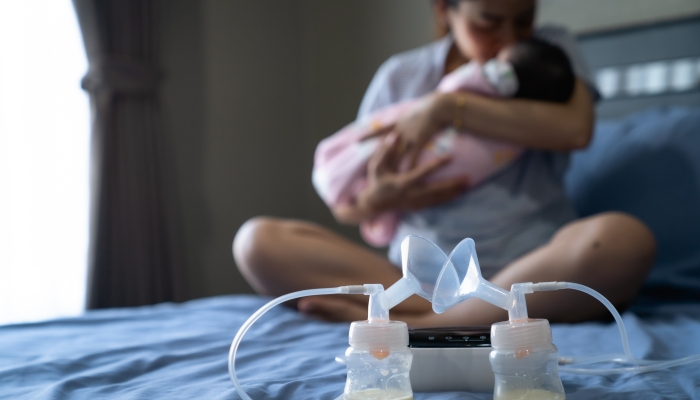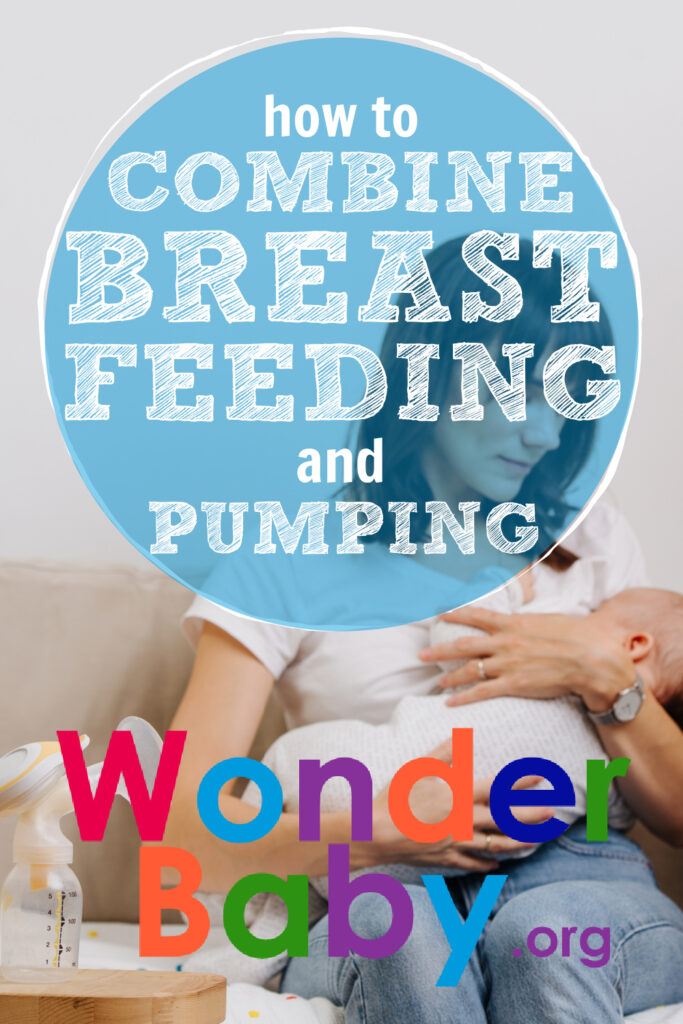How to Combine Breastfeeding and Pumping

This post may contain affiliate links; please see our terms of use for details.
- Breastfeeding and pumping can be used together to benefit you and your baby
- Pumping should follow a similar schedule as breastfeeding
- If pumping and breastfeeding in the same hour, breastfeed first
- Make sure your milk is stored safely and pump parts are clean
- Be patient with yourself and your baby
Breastfeeding and pumping do not have to be exclusive of one another, as long as you know how to combine breastfeeding and pumping. Breastfeeding is a big commitment requiring a lot of time and energy. Exclusively breastfeeding means that your infant requires you to be nearby almost constantly. Giving your baby breast milk in a bottle can help relieve some of this stress.
Combining breastfeeding and pumping takes practice for both you and your baby. However, with practice, combining breastfeeding and pumping can help you lengthen your breastfeeding journey and relieve some of your stress.
Why Should I Pump and Breastfeed?
Some benefits of combining pumping and breastfeeding include:
- Pumping allows you to spend more time away from your baby.
- Bottle feeding provides a way for a second caregiver to bond with the baby.
- Pumping in addition to breastfeeding is a good strategy to increase milk supply.
- Pumping after returning to work means your baby can continue receiving breast milk while you are away.
- Combination feeding can make breastfeeding less stressful and allow you to continue your breastfeeding journey for longer.
Breastfeeding is a fantastic bonding experience for a mom and baby. Oxytocin is a powerful hormone released when you breastfeed that helps you bond with your baby. It is also nice to eliminate a few extra feeding supplies when you are out and about, when all you really need is your body and your baby.
However, being the only person responsible for feeding your baby can be exhausting, especially during a growth spurt or cluster feeding. You might feel like you spend most of your time breastfeeding. Being the only person who can feed your baby during the night adds to the exhaustion of being a new mom.
Pumping in addition to breastfeeding allows you to be away from your baby for longer periods. It also allows other caregivers to bond with your baby. Many fathers and partners will enjoy being able to bond with their baby through bottle feeding.
You might also add pumping between breastfeeding sessions to increase your milk supply. Breasts create more milk as more is demanded, and adding pumping sessions can help you both build up a storage and stimulate your breasts to make more milk.
Some mothers are under the impression that they have to switch to exclusively pumping when they return to work. However, with the right schedule and supplies, you can switch back and forth between pumping and breastfeeding. Combining breastfeeding and pumping allows families to have the best of both.

How Should I Breast Pump?
Choosing a Breast Pump
The first thing you’ll need to begin pumping is a breast pump. Thanks to the Affordable Care Act (Obamacare), new moms can qualify for a new breast pump paid for by their insurance company. Your insurance company will generally cover one electric breast pump.
Options for pumping extra milk include
- Hand Expression
- Manual pump
- Electric pump
- Hands-free pump
Hand expression is free, but is the least efficient of the options. If you find yourself needing to pump without equipment, you can use hand expression to relieve pressure and store some milk for later. If you have a strong letdown, hand expression can provide as much milk as an electric pump. It just might take a little longer.
- Hands Free
- Hands Free
- Hands Free
- Hands Free
The hands-free electric pump is the most efficient. It can be worn underneath your clothing while you work or run errands, allowing you to pump more frequently and without interruptions. However, these pumps are more expensive and are not covered by insurance. They also tend to hold less milk; you can only pump about 5oz of expressed breast milk before you have to change bags.
No products found.
The electric pump falls somewhere in the middle. Prices vary depending on how many extra features you want. Combined with a hands-free bra, the electric pump is a convenient and efficient way to pump breast milk.
Pumping Technique
There are few things more frustrating than an unproductive pumping session. Most women who pump will not produce the same amount of milk each time. Having the right technique is important for getting as much milk as you can with each pumping session.
- Get comfortable
- Try to relax
- Make sure your shields fit properly
- Continue pumping for a few minutes after the last drop
Before you start pumping, make sure you are comfortable. It is hard to make enough milk when you are stressed. Some warm water and massage over your breast tissue can help you relax and prepare to express milk.
Listening to relaxing music or sounds of your baby can also encourage let down. You might choose to read a light novel or watch videos of your baby while you pump. For some women, the sound of the pump causes irritation or anxiety, and drowning this out with headphones can help.
Ill-fitting shields not only inhibit milk release, they can also make pumping painful. For the right fit, the nipple should be centered in the breast shield and move freely with the pump. Too large of a shield will pull the entire areola into the shield, and too small the nipple will not move within the pump.
After your milk flow seems to have stopped, allow the pump to run for a few more minutes. This increases the demand on the breast and your milk production should slowly increase as you continue to use your breast pumps.
Breastfeeding and Pumping Schedules
Creating a schedule that works for your family will take some practice. The most important thing to remember is to breastfeed before pumping as often as you can. Pumping first might mean you do not have enough milk left to meet baby’s demand.
How Often and How Long Should I Pump?
Pumping should follow as closely to your baby’s feeding schedule as possible. This means pumping every 3-4 hours for about 15 minutes each. Using a double breast pump can speed up this process.
To increase milk supply, you might try power pumping. This is a strategy used to increase demand for breast milk and therefore increase breast milk supply. Your breast milk production should increase within a week or two.
To power pump, you will need about an hour of time. Start with twenty minutes of pumping, and then alternate ten minutes of rest and ten minutes of pumping for a total of one hour. This should replace one regular pumping session each day.
How Much Milk do I Need to Pump?
Many women worry that they won’t have a good enough supply before leaving their baby with another caregiver or returning to work. You don’t need to have a freezer full of breastmilk before you go. The general rule is that you pump 1oz for every hour that you will be away from your baby. 9-10oz for an average work day should be just fine, even if you get stuck in a little traffic.
Will Sleeping Through the Night Diminish My Supply?
Many lactation consultants recommend pumping or feeding your baby at least once each night, at least for the first few weeks. Milk supply increases and decreases based on demand. Even women who exclusively pump will need to wake up to pump every 3-4 hours at first.
One way you might be able to get a little more sleep would be to share the load with a partner. You take care of the actual feeding or pumping, and your partner can handle the burping and clean up of the supplies.
As your baby gets older and your supply stabilizes, you should be able to go longer between sessions and pump more breast milk each session.

Pumping and Storing Breastmilk
Cleaning Your Breast Pump
It is important to clean your breast pump parts well between each use. Bacteria love the warm, moist environment that a breast pump provides. Cleaning and drying your pump parts well between each use will keep you and your baby safe.
Steps to clean your breast pump:
- Take apart the entire pump
- Rinse each piece of the pump kit under warm water
- Using cleaning supplies designated for your pump, scrub each piece with soap and hot water
- Rinse by running under warm water or submerging in a clean basin
- Allow parts to completely air dry
Some pump supplies are dishwasher safe. Check the manufacturer’s instructions for specific information.
Storing Your Breast Milk
After you have finished pumping, You will need a safe place to store your milk.
Freshly expressed milk can be stored using these guidelines:
| Room Temperature | Refrigerator | Freezer |
| Up to 4 hours | Up to 4 days | Up to 6 months |
When you have finished pumping breast milk, make sure that it is labeled clearly with your name, the date, and time it was expressed. Using your own mini fridge is a good option for storage.
FAQ’s
Will combining breastfeeding and bottle feeding confuse my baby?
Some babies take longer to learn to use a bottle, and some prefer a bottle over the breast. It will take practice and patience, but it is possible to help your baby learn to do both.
- Wait to introduce a bottle until your baby is one month old
- Use a nipple shield for breastfeeding
- Use a slow-flow nipple for bottle feeding
- Offer whichever source they least prefer when they are tired and hungry
- Hire a lactation consultant
What are the side effects of pumping?
- Mastitis: Inflammation of breast tissue that can lead to an infection. Usually treated with antibiotics.
- Sore nipples: A common side effect of both pumping and breastfeeding, sore nipples can usually be treated by making sure your pump fits properly. If soreness continues, you may want to ask your doctor about thrush, a yeast infection of the nipples.
- Blocked milk ducts: Blockages usually occur when you’re breastfeeding schedule is off. Pumping or feeding more often will generally release any blocks.
Most pumping issues are solved with well-fitting shields and decreasing pump suction. Nipple soreness can be soothed using a good nipple cream.

Related Posts

Breastfeeding, Sleep
Sleep and Breastfeeding: A Comprehensive Guide for Nursing Moms
Many people assume breastfeeding and sleep training don’t go together, but it is possible to help your baby sleep better while continuing your breastfeeding journey.

Breastfeeding
Comfort Nursing: Pros, Cons, and How to Stop
Find out what comfort nursing is, when should you worry about it, and how to stop or limit your baby's comfort nursing (especially at night!).

Breastfeeding, Product Reviews
5 Best Breastfeeding Chairs for Nursing Moms of 2023
Whether you want a gentle rock, a smooth glide, or a cozy cuddle to soothe your baby to sleep, you’ll have your pick of the best breastfeeding chairs on the...
